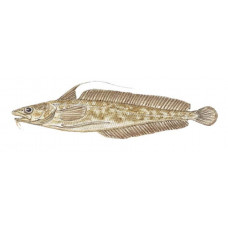Latin name
Urophycis chuss
Other names
Squirrel hake, ling; French: merluche éureuil; Spanish: locha roja.
Identification
The body of the red hake is elongated. The caudal fin is truncated. There is a short antenna on the lower jaw. The pelvic fins are long, narrow, tentacle-shaped. The third ray of the first dorsal fin, threadlike, much longer than the rest. Scales are fairly large. The coloration of the sides is reddish-brown, the back is dark, sometimes almost black, and the lateral line is light. The color of the belly varies from pure white to grayish or yellowish. The dorsal, caudal, and anal fins are dark. The fins do not have dark edging as in some other hake species, and the pelvic fin rays are shorter than in other hake species.
Distribution
Red hake are found from the Gulf of St. Lawrence to North Carolina, but are most abundant between Georges Bank and New Jersey. Studies from bottom trawl surveys show that red hake has a wide geographic and depth distribution throughout the year, undergoing extensive seasonal migrations.
Habitat
They live in deep waters on soft or sandy bottoms. Juveniles may often be found in shallow water along the coast, adults usually migrate to deeper water, usually at a depth of 300 to 400 feet, according to some reports, they live in depths of more than 1,650 feet. Adult fish are predominantly bottom-dwelling, occasionally rising into the water column. Does not make regular vertical movements during the day. Prefers soft, muddy ground. Depending on season, it is found at depths from 30 to 300 m at water temperature 4-12°С.
Size
The maximum length of a red hake is about 50 centimeters, or about 191⁄2 inches. Their maximum age is reported to be about 12 years, but few fish live to be 8 years old. The world record in tackle is 7 pounds, 15 ounces, which is their known maximum size; the usual size is about 2 pounds. Red hake reach sexual maturity in weight in the third to fourth year of life.
Life history and Behavior
Red hake overwinter in the deep waters of the Gulf of Maine and along the outer continental shelf and slope south and southwest of Georges Bank. Spawning occurs from May through November, and significant spawning areas are located in the southwestern part of George's Bank and in southern New England south of Montauk Point, Long Island.
Food and feeding habits
Young fish eat shrimp, amphipods, crabs, and other small crustaceans that live near the bottom. Adult fish partially switch to eating squid, juvenile herring, mackerel, silver hake, butterfish and other fish.
Reproduction
Most likely spawning parties. Spawning extends from May to September. Spawning peaks in late June-July. The largest spawning ground is located on the southeastern slope of Georges Bank. Fecundity averages 460,000 eggs, with the largest specimens having up to 1 million eggs. The eggs are pelagic, transparent, spherical shape, 0.72-0.76 mm in diameter, with several small colorless fat droplets on the yolk, which merge soon after fertilization into one large droplet, 0.15-0.17 mm in diameter. The larvae stay in the upper fifty-meter layer of water. In late summer and autumn, fry, which are 3 cm in length, begin to descend to the bottom, where they find shelter in seagrass beds or in the mantle cavity of bivalve mollusks. Fry do not leave their shelters until the spring of the following year, when they are 7-11 cm in mass.
| Classification | |
| Phylum | Chordata |
| Class | Actinopterygii |
| Squad | Gadiformes |
| Family | Phycidae |
| Genus | Urophycis |
| Species | U. chuss |
| Features | |
| Conservation status | Least Concern |
| Habitat | Pelagic |
| Life span, years | No information |
| Maximum body weight, kg | 3.5 |
| Maximum length, cm | 75 |
| Sailing speed, m/s | No information |
| Threat to people | Edible |
| Way of eating | predator |



